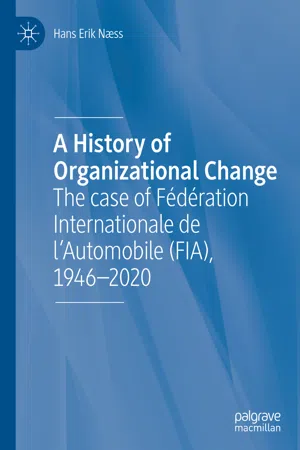After a modest start in 1904, when it was named the Association Internationale des Automobile Clubs Reconnus (AIACR), the Fédération Internationale de l’Automobile (FIA) (renamed such in 1946) has become one of the most influential sport governing bodies in the world. To explain why and how, let me introduce three vignettes in which the FIA has been the centre of attention in the years of 2019–2020:
The three vignettes above illustrate some of the diversity and scope of today’s FIA, which holds, in its own words, ‘the exclusive right to take all decisions concerning the organisation, direction and management of International Motor Sport’ (FIA Activity Report, 2016, p. 1). Located in three cities—Geneva, Valleiry, and Paris (its headquarters)—it consists in 2020 of 240 member clubs from 144 countries. Those represent in total about 80 million members, and host together, with the FIA, a network of stakeholders and engage in activities that the organisation’s first members would probably have found unimaginable. More than half a century ago, when everybody was picking up the pieces after World War II, the situation was quite different. By then, the Association Internationale des Automobile Clubs Reconnus (AIACR) had already been active for some time. At a meeting at Bad Homburg in Germany on 20 June 1904, hosted by Duke Victor of Ratibor, it was proposed to form ‘an international association of automobile clubs’ (Hutton, 2004, p. 23). It was a private association whose statutes emphasised that member clubs should deal with ‘all questions related to motoring’ (Hutton, 2004, p. 32), and in which a group of idealistic and wealthy people came together through their fascination for cars, road travel, and motorsports. Unpaid and in the service of their national clubs, these individuals hailed from upper-class backgrounds across Europe and the US. Politically and religiously neutral, not profit-oriented and with membership responsibilities enshrined in its statutes, it began to promote a form of transport which came to transform societies more than any other in the coming century.
The French Connection
In the centre of it all was Paris. Around the turn of the twentieth century, French and German inventors competed fiercely to become the first mass manufacturer of cars. In 1896, Armand Peugeot established Anonyme des Automobiles Peugeot and focused on developing internal combustion engines—a critical choice, it would turn out, because of the early links between the automotive industry and motorsport events as performative showrooms. After the races from Paris-Rouen (first run in 1894), Paris-Bordeaux and back (1895), and Chicago to Evanston (1895), which were all won by petroleum-based cars, it became clear that petrol-powered engines outperformed steam and electricity as power sources. Stimulated by the interest in these events, and in the car in general, motoring interests from racing, international touring, and continental travel were early served by the establishment of Touring Club de France (Touring Club de France (TCF), 1890) and the Automobile Club de France (Automobile Club de France (ACF), 1895). These associations promoted easier international travel by car and road races, and acquired public support and industrial momentum both of which, among other things, manifested themselves in the early use of international conventions to showcase the novelties of the car industry. The first Salon d’Automobile took place on 15 June 1898 in the Tuileries Gardens, where exhibitors were ‘required to demonstrate their wares by driving their cars from Versailles to Paris’ (FIA, 2014, p. 11). Two years later, Paris hosted the first Congrès International d’Automobilisme, coinciding with the World Exhibition in the French capital. In fact, it is argued, ‘Paris’ pioneering role in the development of the automobile was supported by the fact that Parisians widely and enduringly embraced the automobile until the 1970s’ (Schipper, 2008, p. 46).
To strengthen the relationship between racing and marketing, the ACF, which grew from 422 members in 1896 to 2261 in 1901 (Flink, 1988, p. 18), established its first Sporting Commission in 1899, dealing with ‘all issues related to road vehicle events’. This experience would give the French the lead in their subsequent collaboration with other national motoring clubs when organising cross-country races like the Paris-Madrid race in 1903 (FIA, 2014, p. 13), and, more importantly, was a decisive motivation for establishing AIACR in 1904. Besides adopting both the ACF’s guidelines for motoring and its president between 1904 and 1931, Baron de Zuylen de Nyevelt, the aristocrats forming the ACF in 1895 had purchased two large sections of the former Place Louis XV (currently Place de la Concorde)—which is still the FIA’s headquarters. The ACF remained in number 6...
